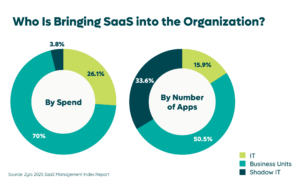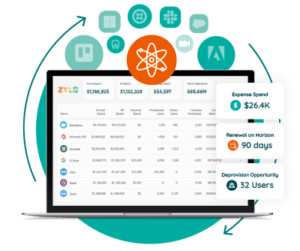Table of Contents
Gone are the days when an enterprise’s IT team held sole responsibility for procuring and managing software. These days, teams and individuals often hold the power. Our 2025 SaaS Management Index found that IT owns just 26% of SaaS spend and 16% of all SaaS applications.
 By design, cloud-based software applications are much easier to access than on-premise solutions. In effect, a SaaS application is simply a website that requires log-in credentials. Gaining access is as easy as inputting a credit card number and submitting the expense for reimbursement – a practice that’s often referred to as shadow IT. And it’s a lot more common than you may think. Per our report, about one in every fifteen employees expense SaaS.
By design, cloud-based software applications are much easier to access than on-premise solutions. In effect, a SaaS application is simply a website that requires log-in credentials. Gaining access is as easy as inputting a credit card number and submitting the expense for reimbursement – a practice that’s often referred to as shadow IT. And it’s a lot more common than you may think. Per our report, about one in every fifteen employees expense SaaS.
Providing employees with freedom when it comes to the tools they use isn’t necessarily a bad thing. In fact, many would argue that it allows for increased agility and innovation. In addition, providing this freedom can help businesses attract and retain employees. According to a report from Forrester, 66% of Gen Z and Millennial information workers indicate that freedom in choosing the apps, services, and devices they use for work is a top priority.
But there’s no denying the dark side of shadow IT.
When teams and individuals procure their own SaaS, duplicative and redundant software often runs rampant – which leads to unnecessary spending. What’s more, each unvetted application that enters the ecosystem introduces risk.
Clearly, shadow IT can be a big problem. But how exactly do you address it? Here at Zylo, we recommend a proven, three-step framework for enterprises to reduce shadow IT – and rightsize the entire SaaS portfolio.
Rightsizing SaaS Step 1: Discover All SaaS Throughout the Organization
Before you can rightsize your SaaS portfolio, you must first get a clear picture of what it looks like today. This is one of those situations where guesses aren’t good enough, as most organizations consistently underestimate how many SaaS applications they have by two to three times.
Shed Light on All SaaS Within the Organization
 Instead, you’ve got to gather data that helps you shed light on each and every SaaS application that’s been purchased by your company – including those purchased by IT, teams, and even individuals. Gather key data for each application, including:
Instead, you’ve got to gather data that helps you shed light on each and every SaaS application that’s been purchased by your company – including those purchased by IT, teams, and even individuals. Gather key data for each application, including:
- Number of active users.
- Years the organization has utilized the supplier. This helps to evaluate net new suppliers versus incumbent suppliers – and to what extent.
- Business units involved in the purchase and use of the application.
Classify Apps According to Business Impact
Once you’ve gathered all the necessary data, you’ll need to classify each application into one of three tiers according to its impact level on the business.
- Tier One: High impact (often highest-cost, IT-owned, widely used apps)
- Tier Two: Moderate impact (often departmental apps)
- Tier Three: Remaining applications (often long tail apps with niche use cases)
Collaborate with Business Units Determine Business Value
After you’ve gained visibility into all SaaS applications and bucketed each accordingly, it’s time to dig deeper into how each is being used and the value it is (or isn’t) delivering to the business. This is a process that’ll require you to partner with the experts: those who are using each app in question.
Part of this process will involve conducting application overview sessions with business and application subject matter experts (SMEs). It may be necessary to collect additional data by distributing a questionnaire to stakeholders.
Your goal during should be to understand the following factors for each application:
- Effectiveness: The extent to which an application is a solution for the goals you’re trying to achieve.
- Capability: The degree to which an application is critical in supporting business capabilities.
- Utilization: How many people who have a license are actually using it. A good way to determine utilization is to measure the percentage of active users over a 90-120 day time span. A best practice is to aim for a SaaS utilization rate of 90% or higher.
- Complexity: The customization, unique features, and functions enabled by the application. Applications with greater complexity typically require unique skills to develop and maintain, satisfy more technically difficult requirements, or pull from multiple data sources.
- Usability: How easy it is for the user to operate or learn how to use the application.
Rightsizing SaaS Step 2: Ideate
After you’ve gotten the right quantitative and qualitative data for each application, the next stage of the framework is to distinguish business wants from business priorities. In other words, you’ve got to ask yourself, “Are we using this app because it’s new and shiny? Or are we using it because it helps the business increase productivity?” If it’s the latter, it’s important to establish what business priorities and capabilities it supports.
Then, you can start socializing the current state of SaaS and ideate opportunities for optimization.
Map Solutions to Company Goals
It’s important to map each solution to capabilities required to achieve your company’s goals, a process commonly referred to as application mapping. The goal is to answer a few key questions about each app.
- Why do we have this application?
- How does this contribute to the success of the company?
- Who utilizes it and who are their customers/partners?
Answering these questions and mapping your applications will involve:
- Analyzing the information exchange and data flows across applications to identify the challenges and gaps (if any).
- Analyzing and identifying the data to identify duplication or redundancies.
- Outlining utilization trends over a 12-18 month period.
Socialize the Current State of SaaS
It’s also key to socialize the state of SaaS as it is today at your organization and share the top challenges and areas for improvement. Essentially, this involves broadly broadcasting the problem statement – which is arguably the most overlooked part of SaaS management. This “state of the union” allows every employee to see the exact same data at the same time. And it’s designed to quell pushback down the road.
Let’s give you a real-life example. The SAM team at a large global enterprise found that 500 employees were provisioned access to six or more project management tools. Obviously, this was a huge opportunity for improvement. And when they socialized the hard data, it left no room for denial.
Rightsizing SaaS Step 3: Score and Make Recommendations
Based on the data and feedback you’ve gathered during the previous steps, it’s time to score each application and provide your recommendations for moving forward.
Score Applications
Each individual application should be scored based on the business value, technical fit, and the total cost of ownership (TCO). Based on those scores, you can determine which “R” action should be taken for each:
- Reviewed: An application isn’t eliminated, but it’s not guaranteed to stay either. Further collaboration is required.
- Rewarded: An application meets requirements in terms of directly correlated to business capability. Therefore, it’s kept in the portfolio. Ideally, the app will absorb active users of an application that is being removed.
- Refreshed: An application is kept as is.
- Removed: The application is eliminated. These applications have active users who now need a new home now that the application is being removed. Ideally, these users will adopt the product that’s been “rewarded.”
Provide Recommendations
Based on the scores assigned to each application, you can now recommend a rationalized set of best fit applications. Be sure to include contract dates as part of your recommendations so it’s clear when the organization can begin realizing cost savings. Your proposed roadmap should also factor in constraints from varying business units with high-impact in-flight projects.
Start Rightsizing Your SaaS Portfolio
The portion of SaaS purchased and managed by teams and individuals will only continue to grow. While shadow IT may speed innovation and boost employee experience, it also introduces unnecessary costs and risk. Now’s the time to take action to rightsize your SaaS portfolio.
Looking for more resources to get started? Check out our Practical Guide to Rationalizing, Rightsizing, and Renewing SaaS to start putting these strategies into practice at your organization now.

